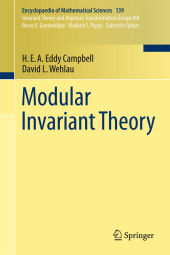 Neuerscheinungen 2013Stand: 2020-01-07 |
Schnellsuche
ISBN/Stichwort/Autor
|
Herderstraße 10
10625 Berlin
Tel.: 030 315 714 16
Fax 030 315 714 14
info@buchspektrum.de |

H. E. A. Eddy Campbell, David L. Wehlau
(Beteiligte)
Modular Invariant Theory
2011. 2013. xiv, 234 S. XIV, 234 p. 235 mm
Verlag/Jahr: SPRINGER, BERLIN 2013
ISBN: 3-642-26680-0 (3642266800)
Neue ISBN: 978-3-642-26680-5 (9783642266805)
Preis und Lieferzeit: Bitte klicken
This book covers the modular invariant theory of finite groups. It details techniques for the computation of invariants for many modular representations of finite groups, especially the cyclic group of prime order, and includes many examples.
This book covers the modular invariant theory of finite groups, the case when the characteristic of the field divides the order of the group, a theory that is more complicated than the study of the classical non-modular case. Largely self-contained, the book develops the theory from its origins up to modern results. It explores many examples, illustrating the theory and its contrast with the better understood non-modular setting. It details techniques for the computation of invariants for many modular representations of finite groups, especially the case of the cyclic group of prime order. It includes detailed examples of many topics as well as a quick survey of the elements of algebraic geometry and commutative algebra as they apply to invariant theory. The book is aimed at both graduate students and researchers-an introduction to many important topics in modern algebra within a concrete setting for the former, an exploration of a fascinating subfield of algebraic geometry for the latter.
1 First Steps.- 2 Elements of Algebraic Geometry and Commutative Algebra.- 3 Applications of Commutative Algebra to Invariant Theory.- 4 Examples.- 5 Monomial Orderings and SAGBI Bases.- 6 Block Bases.- 7 The Cyclic Group Cp.- 8 Polynomial Invariant Rings.- 9 The Transfer.- 10 Invariant Rings via Localization.- 11 Rings of Invariants which are Hypersurfaces.- 12 Separating Invariants.- 13 Using SAGBI Bases to Compute Rings of Invariants.- 14 Ladders.- References.- Index.


